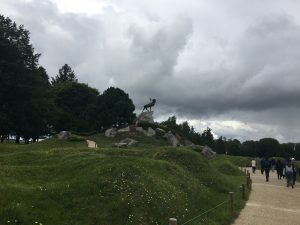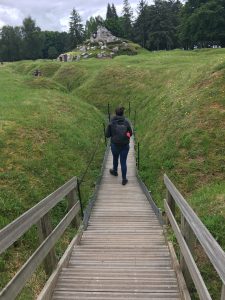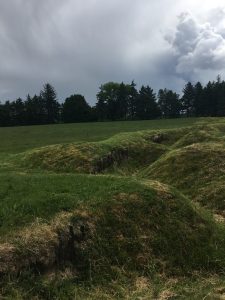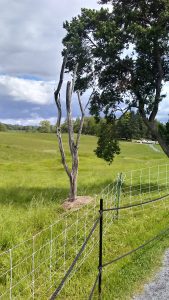 Today we visited several different memorial sites connected to the Battle of the Somme (July 1-November 18, 1916), including the Newfoundland Memorial at Beaumont-Hamel, Thiepval Memorial, and Courcelette. The whole day was very though-provoking and for me, the Newfoundland Memorial was particularly poignant. Throughout the day the weather shifted back and forth between sunshine and rain, and this was the case during the hour and a half we spent at the Newfoundland Memorial. The park is set in the Somme battlefield and the ground is riddled with the remains of old trenches and shell holes, which gives it an eerie green wave effect. It is a beautiful place but it carries a deep sadness that comes from the knowledge of the massive loss of life that occurred on the pockmarked hill.
Today we visited several different memorial sites connected to the Battle of the Somme (July 1-November 18, 1916), including the Newfoundland Memorial at Beaumont-Hamel, Thiepval Memorial, and Courcelette. The whole day was very though-provoking and for me, the Newfoundland Memorial was particularly poignant. Throughout the day the weather shifted back and forth between sunshine and rain, and this was the case during the hour and a half we spent at the Newfoundland Memorial. The park is set in the Somme battlefield and the ground is riddled with the remains of old trenches and shell holes, which gives it an eerie green wave effect. It is a beautiful place but it carries a deep sadness that comes from the knowledge of the massive loss of life that occurred on the pockmarked hill. 
The Newfoundland Regiment participate d in their first major engagement after being stationed at Gallipoli at the Somme on July 1, 1916. In the short battle the Regiment sustained a nearly 80% casualty rate within the first 20 minutes of the attack, which is why the people of Newfoundland committed to building a memorial, and the whole site is now maintained and run by Parks Canada.
d in their first major engagement after being stationed at Gallipoli at the Somme on July 1, 1916. In the short battle the Regiment sustained a nearly 80% casualty rate within the first 20 minutes of the attack, which is why the people of Newfoundland committed to building a memorial, and the whole site is now maintained and run by Parks Canada.
Walking through the quiet site really helps build a clearer idea of what trench warfare and fighting through mud and up and down hills would have been like. Some of the trenches (a mixture of German and British) are still big enough to walk through and it helps to be able to imagine the sense of smallness that many of the soldiers must have felt when they were preparing to cross No Man’s Land and attack the enemy on the other side.
The site is a beautiful memorial to the sacrifices made by the men who fought in the viciously deadly Battle of the Somme during the Great War.
— Haley Kloosterhof

